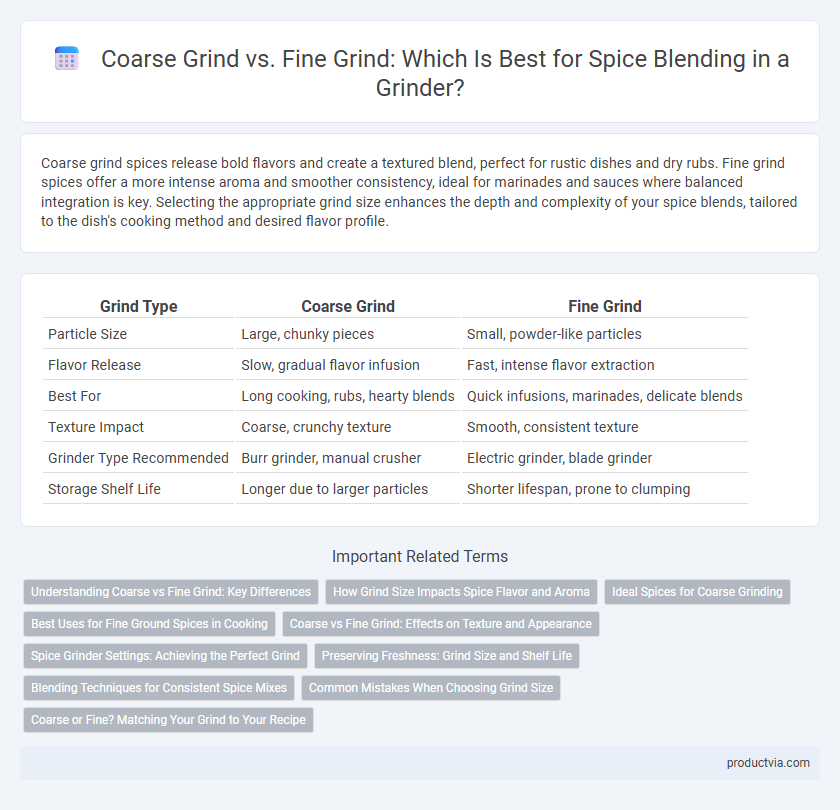Coarse grind spices release bold flavors and create a textured blend, perfect for rustic dishes and dry rubs. Fine grind spices offer a more intense aroma and smoother consistency, ideal for marinades and sauces where balanced integration is key. Selecting the appropriate grind size enhances the depth and complexity of your spice blends, tailored to the dish's cooking method and desired flavor profile.
Table of Comparison
| Grind Type | Coarse Grind | Fine Grind |
|---|---|---|
| Particle Size | Large, chunky pieces | Small, powder-like particles |
| Flavor Release | Slow, gradual flavor infusion | Fast, intense flavor extraction |
| Best For | Long cooking, rubs, hearty blends | Quick infusions, marinades, delicate blends |
| Texture Impact | Coarse, crunchy texture | Smooth, consistent texture |
| Grinder Type Recommended | Burr grinder, manual crusher | Electric grinder, blade grinder |
| Storage Shelf Life | Longer due to larger particles | Shorter lifespan, prone to clumping |
Understanding Coarse vs Fine Grind: Key Differences
Coarse grind produces larger, uneven spice particles that release flavor slowly, ideal for longer cooking processes and robust spice blends. Fine grind creates uniform, smaller particles with a more intense and immediate flavor release, perfect for quick infusion and delicate seasonings. Understanding the texture and surface area difference between coarse and fine grinds helps optimize spice blending for desired taste profiles and cooking methods.
How Grind Size Impacts Spice Flavor and Aroma
Coarse grind preserves essential oils and volatile compounds in spices, resulting in a bolder, more robust flavor and longer-lasting aroma during cooking. Fine grind increases surface area, enhancing spice release and intensity but can cause rapid flavor loss due to quicker oxidation. Choosing the right grind size balances flavor extraction and aroma retention, crucial for optimal spice blending outcomes.
Ideal Spices for Coarse Grinding
Coarse grinding is ideal for robust spices such as peppercorns, coriander seeds, fennel, and mustard seeds, preserving their essential oils and releasing complex flavors during cooking. The larger particle size enhances texture and visual appeal in blends, making them perfect for dry rubs and marinades. Coarse grind maximizes aromatic impact while providing a balanced spice profile in culinary applications.
Best Uses for Fine Ground Spices in Cooking
Fine ground spices offer superior flavor release and even distribution, making them ideal for baking, sauces, and delicate dishes where subtlety and precision are essential. Their small particle size enhances absorption and infusion into liquids and fats, optimizing the taste and aroma of marinades, rubs, and dressings. Using fine grind ensures a consistent spice blend, enhancing the overall complexity and balance of culinary creations.
Coarse vs Fine Grind: Effects on Texture and Appearance
Coarse grind creates larger, uneven spice particles that enhance texture by adding a rustic, crunchy feel to blends, making them visually distinct and ideal for rubs or dry marinades. Fine grind produces uniform, powdery spices that dissolve quickly, delivering a smoother texture and consistent color, perfect for seasoning blends and sauces. The choice between coarse and fine grind directly influences the mouthfeel, flavor release rate, and overall presentation of spice blends.
Spice Grinder Settings: Achieving the Perfect Grind
Spice grinder settings determine the coarseness or fineness of ground spices, directly impacting flavor release and blend consistency. Coarse grind retains larger spice particles, enhancing texture and gradual flavor infusion in dishes, while fine grind releases essential oils quickly, intensifying aroma and taste in spice blends. Adjusting grind size on a spice grinder achieves the perfect balance, optimizing spice extraction to suit specific culinary applications.
Preserving Freshness: Grind Size and Shelf Life
Coarse grind preserves spice freshness longer by reducing surface area exposed to air, slowing oxidation and flavor loss. Fine grind accelerates aroma and essential oil evaporation due to increased exposure, shortening shelf life. Choosing the right grind size balances flavor intensity with optimal preservation for blended spices.
Blending Techniques for Consistent Spice Mixes
Coarse grind allows spices to retain distinct textures and bursts of flavor, making it ideal for blends requiring a robust, layered taste profile. Fine grind ensures uniform particle size, promoting even distribution of flavors and smoother integration in spice mixes for consistent results. Selecting the appropriate grind size influences the extraction rate and overall balance, critical for achieving a harmonious and repeatable spice blend.
Common Mistakes When Choosing Grind Size
Choosing the wrong grind size for spice blending can lead to uneven flavor extraction and inconsistent texture, especially when using a coarse grind that may not release aromas effectively. Fine grinds risk clumping and overpowering other ingredients due to their intense and rapid flavor release, which is a common mistake in balancing spice blends. Avoiding these pitfalls requires understanding the specific role each grind size plays in enhancing the overall sensory profile of the blend.
Coarse or Fine? Matching Your Grind to Your Recipe
Choosing the right grind size is essential for spice blending, as coarse grind releases robust flavors ideal for slow-cooked dishes and dry rubs, while fine grind provides quick flavor infusion suited for marinades and delicate recipes. Coarse grind retains more texture and visual appeal, enhancing the sensory experience in stews and roasted meats. Fine grind offers uniform distribution, perfect for baking and sauces that require smooth consistency and immediate flavor release.
Coarse grind vs Fine grind for spice blending Infographic

 productvia.com
productvia.com